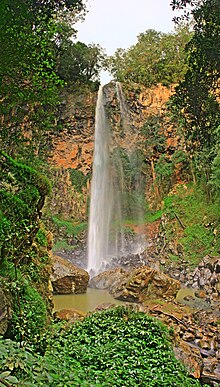Boorganna Nature Reserve
| Boorganna Nature Reserve NSW National Parks & Wildlife Service | |
|---|---|
| Website | Boorganna Nature Reserve |
| See also | Protected areas of New South Wales |
The Boorganna Nature Reserve is a protected
Location and features
A picnic area next to the forest provides chairs and tables for visitors. Walking trails, a lookout to Rawson Falls and an information board is also provided. Picnics provide a pleasant view of the nearby area. A variety of small birds appear from the edge of the forest. The reserve is situated 32 kilometres (20 mi) north of
Geology and climate
The reserve receives an average annual rainfall of 1,930 millimetres (76 in).[2][5] The climate is sub tropical, though at an elevation ranging from 360 to 732 metres (1,181 to 2,402 ft),[2] it is cooler than at the coast nearby. Soils are derived from Miocene basalt, which provide a deep red loam. Below the basalt are less fertile sedimentary rocks. The western area of the reserve where it adjoins the Great Dividing Range has partly eroded, forming areas of cliffs, rocks and shallow soils. Deep gullies, isolated hills and sharp edged rocky ridges occur here. Rocks include pebbly mudstone, conglomerate siltstone and shale. Serpentinite outcrops can also be seen.
Fauna
Animals are seldom seen in the rainforest, being nocturnal. However, many species live in the reserve. Such as a bats,
Bird life is varied and extensive with around a hundred species recorded. Many rainforest pigeons frequent the reserve such as the
Invertebrate biology is not so well understood. However, a vast number of insects, arachnids, molluscs, worms and other small creatures live in the rainforest.
Flora
Sub tropical rainforest

The jungle or sub tropical rainforest features a dark forest with many large trees. Several species grow to great height and a broad trunk diameter, such as
Boorganna Nature Reserve features several plants at or near their most southern limit of natural distribution. Such as the
The
Warm temperate rainforest
Below the more fertile basalt is a poorer soil type. Warm temperate species are more frequently seen here, such as the
Gully rainforest
Gully rainforest occurs south of Mumford's Creek, in steep sided narrow gullies. Plant species from the sub-tropical and warm
Dry rainforest
Where the soil is shallow, and conditions are exposed to winds and fire is infrequent, dry rainforest occurs. Rainforest tree species in this area include the
Eucalyptus forest
Eucalyptus forest occurs in areas where fires often occur. In the wetter areas are
Fungi
At Boorganna Nature Reserve fungi is noticeable and often colourful and spectacular, particularly after rain in the autumn.[12] The bracket rainbow fungus often appears on fallen logs.
Photos from Boorganna Nature Reserve
-
Picnic area by the carpark at Boorganna Nature Reserve
-
Rawson Falls
-
base of Rawson Falls
-
Sour cherry at Boorganna Nature Reserve
-
Small leaf figat Boorganna Nature Reserve
-
Small leaf figbark at Boorganna Nature Reserve
-
Rosewood at Boorganna Nature Reserve
-
Pigeonberry ash at Boorganna Nature Reserve
-
White beechat Boorganna Nature Reserve
-
Rainbow bracket fungi at Boorganna Nature Reserve
-
Fungi at Boorganna Nature Reserve
See also
References
- ^ "Boorganna". Protected Planet. Retrieved 30 December 2018.
- ^ )
- ^ a b "Boorganna Nature Reserve". Office of Environment & Heritage. Government of New South Wales. Retrieved 14 September 2014.
- ^ Geoff Williams, former CEO of Australia Heritage. Who said that "Brussels saw them as disjunct units rather than a continuum". So, an omission based on ignorance, bias or whim. (Personal Communication).
- ^ "Peace, Quiet & Fresh Mountain Air". Comboyne. Archived from the original on 25 February 2012. Retrieved 9 August 2012.
- ISBN 0-949324-32-9.
- ^ JSTOR 2257290.
- ^ "Boorganna Nature Reserve" pamphlet 1977, National Parks & Wildlife Service
- ^ "Lost & Found, Nothofagus moorei at Comboyne. authors C.L. Bale & J.B. Williams" (PDF). Cunninghamia. Archived from the original (PDF) on 16 March 2017. Retrieved 21 February 2017.
- ISBN 978-0-958943-67-3. Retrieved 20 February 2017.
- ISBN 0-949324-32-9.
- ^ "Boorganna Nature Reserve - visitor information". National Parks & Wildlife Service of New South Wales.
External links
- "Boorganna Nature Reserve". Office of Environment & Heritage. Government of New South Wales.
- "Boorganna Nature Reserve". Comboyne.org. Archived from the original on 13 September 2009. Retrieved 4 July 2009.
- Boorganna Nature Reserve: Plan of Management (PDF) (PDF). )











